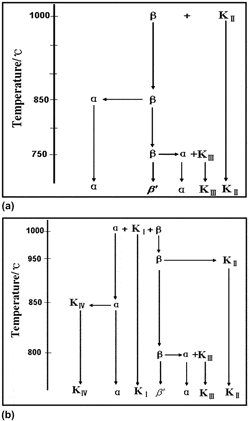Article contents
A comparative study on effects of special casting processes on microstructural development in Cu–10Al–4Fe–4Ni alloy
Published online by Cambridge University Press: 22 October 2013
Abstract

Suction casting (SC) and centrifugal casting (CC) are two common special casting processes. The influences of SC and CC on the microstructural development of Cu–10Al–4Fe–4Ni aluminum bronzes were investigated with continuous cooling method. The results indicate that α, β′, KII, and KIII phases are observed in the quasicast microstructure via the SC process with the precipitation sequence of KII → α → KIII. Additionally, KI and KIV are observed in the quasicast microstructure via the CC process with the precipitation sequence of α + KⅠ → KII → KIV → KIII. Phase initial precipitation temperatures of the CC process are higher than that of the SC process, especially for α phase. As the quenching temperature decreases, the hardness of both alloys shows a rapid decline trend and finally reaches a steady state. It is found that the eutectoid decomposition (β → α + KIII) barely affects the hardness of the alloys.
- Type
- Articles
- Information
- Copyright
- Copyright © Materials Research Society 2013
References
REFERENCES
- 2
- Cited by


